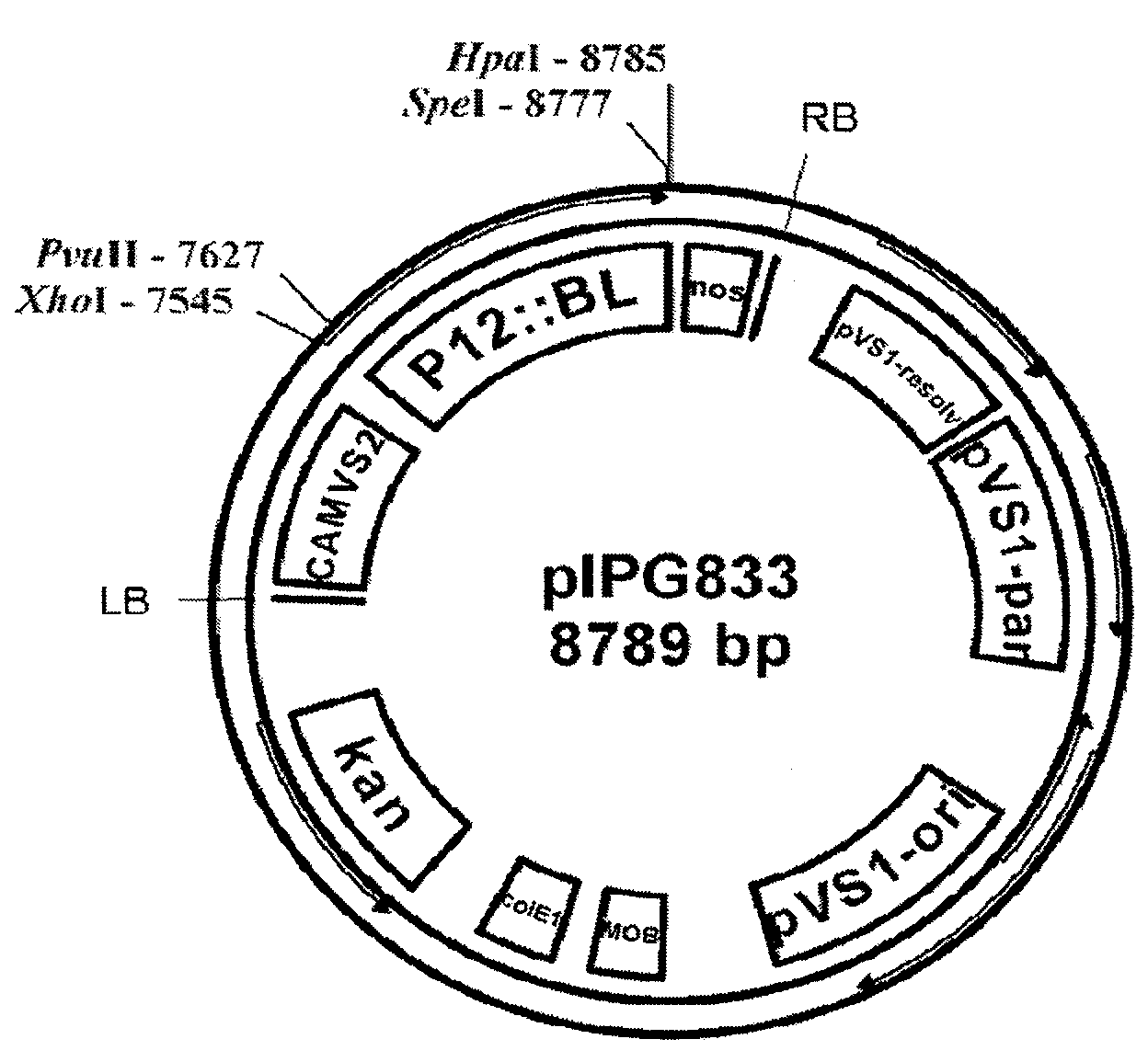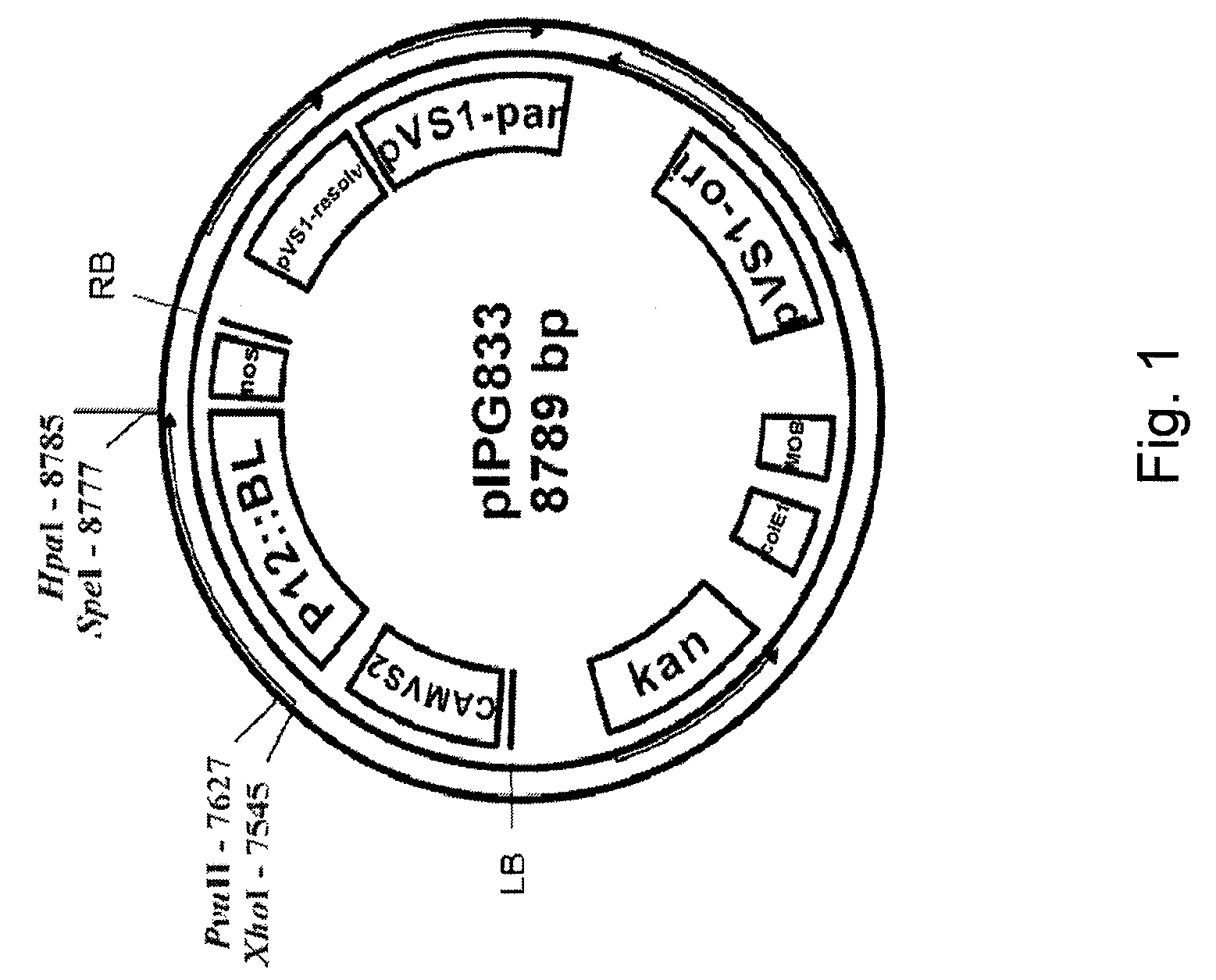Use of Esterase Genes as Selectable Markers for Transforming Plant Cells
a technology of plant cells and esterase genes, applied in the field of gene engineering and plant biology, can solve the problems of not being sufficient for regenerated plants to be sufficient, and achieve the effect of strong inhibition of plant cell regeneration
- Summary
- Abstract
- Description
- Claims
- Application Information
AI Technical Summary
Benefits of technology
Problems solved by technology
Method used
Image
Examples
example 1
Determination of Effective Selective Agent Concentrations for Use in Transformations of Geranium
[0149]Tween 20, a nonionic, fatty acid ester detergent, was evaluated as a potential selective agent for use in geranium (Pelargonium X hortorum) transformation experiments by placing geranium petiole explants into tissue culture with the addition to Tween 20 to the regeneration (shooting) medium normally used in geranium transformations (Robichon et al., 1995). Tween 20 was added at three concentrations: 1%, 0.1% and 0.01%. Each treatment consisted of 40 sterilized petiole explants placed in four tissue culture plates carrying 10 explants each. Survival of the explants was assayed weekly over four weeks on these media. Potential selective agent Span 20, also a nonionic, fatty acid ester detergent, was similarly evaluated, except that concentrations of 1%, 0.5% and 0.25% were evaluated over a twelve week period of time. The nonionic detergent Triton X-100, which is not a fatty acid ester ...
example 2
Determination of an Effective Selective Agent Concentration for Use in Transformations of Tomato
[0151]Tween 20 was similarly evaluated as a potential selective agent for use in tomato (Lycoperisicon esculentum) transformations by placing tomato leaf explants placed into tissue culture; Tween 20 was added to tomato regeneration (shooting) medium normally used in tomato transformations (Riggs et al., 2001) at a 1% concentration. Each treatment consisted of 40 sterilized leaf explants placed in four tissue culture plates carrying 10 explants each. Survival of the explants was assayed weekly over four weeks on these media. The survival results were as follows:
TABLE 2Survival of tomato leaf explants on regenerationmedium in the presence of the indicated detergents.TreatmentWeek 1Week 2Week 3Week 41% Tween 20 8 / 40 8 / 40 3 / 400 / 401% Triton X40 / 4040 / 4010 / 407 / 40
[0152]As may be seen in Table 2, Tween 20 completely killed all tomato explants in four weeks. Triton X was again both less effective ...
example 3
Determination of an Effective Selective Agent Concentration for Use in Transformations of Rice
[0153]Span 20 was evaluated as a potential selective agent for use in transformation of rice (Oryza sativa japonica var. TP-309) in a manner similar to that described in Examples 1 and 2, except that the regeneration (shooting) medium used was appropriate for regeneration of rice from callus produced from seeds (Hiei et al., 1997). Selection of rice normally requires longer periods of time than geranium or tomato. Survival results were as follows:
TABLE 3Survival of rice grain explants on regeneration mediumin the presence of Span 20.TreatmentWeek 4Week 14Week 20 1% Span 2060 / 60 5 / 600 / 600.5% Span 2060 / 6012 / 602 / 60
[0154]As may be seen in Table 3, 1% Span 20 completely killed all rice explants in twenty weeks. Taken together with Examples 1 and 2, this example demonstrates that the nonionic, fatty acid ester detergent Span 20 can be used to kill cells in tissue culture of the monocot rice, as ...
PUM
| Property | Measurement | Unit |
|---|---|---|
| diameter | aaaaa | aaaaa |
| diameter | aaaaa | aaaaa |
| optical density | aaaaa | aaaaa |
Abstract
Description
Claims
Application Information
 Login to View More
Login to View More - R&D
- Intellectual Property
- Life Sciences
- Materials
- Tech Scout
- Unparalleled Data Quality
- Higher Quality Content
- 60% Fewer Hallucinations
Browse by: Latest US Patents, China's latest patents, Technical Efficacy Thesaurus, Application Domain, Technology Topic, Popular Technical Reports.
© 2025 PatSnap. All rights reserved.Legal|Privacy policy|Modern Slavery Act Transparency Statement|Sitemap|About US| Contact US: help@patsnap.com



